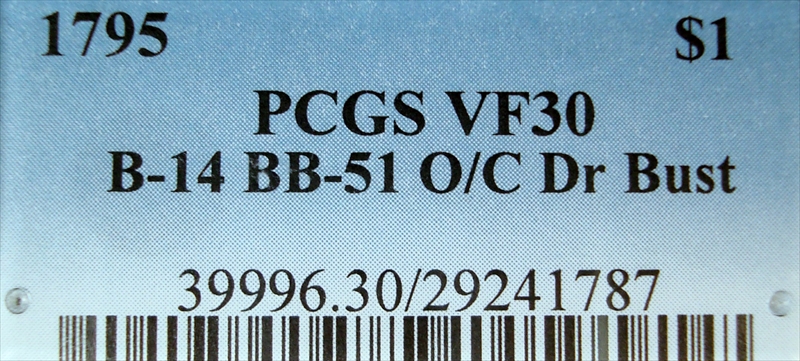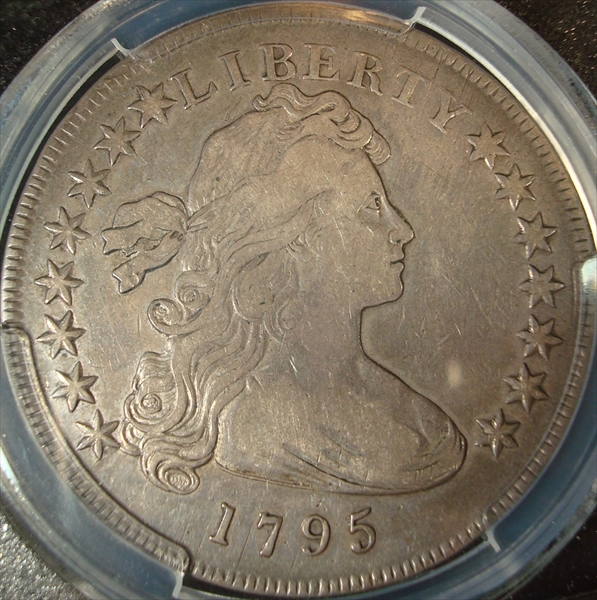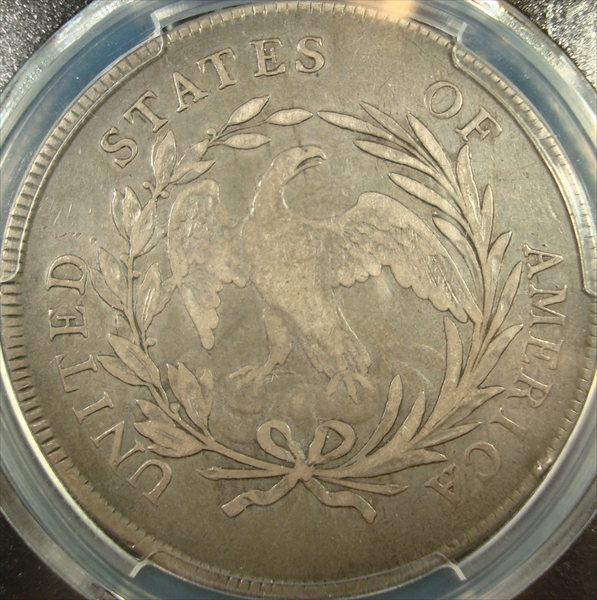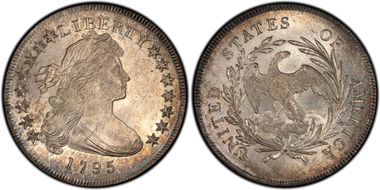1795 $1 BB-51, Off-Center Bust VF30 认证号29241787, PCGS号39996
专家评论
Q. David Bowers
The following narrative, with minor editing, is from my "Silver Dollars & Trade Dollars of the United States: A Complete Encyclopedia" (Wolfeboro, NH: Bowers and Merena Galleries, Inc., 1993). Note: the Notable Specimens list should be used with caution - it has been updated in my 2013 edition of "The Encyclopedia of United States Silver Dollars 1794-1804."(B-14. H-14)
OBVERSE 10: Bust of Miss Liberty facing right, the hair tied up in a ribbon at back. The bust was not properly centered in the die work, being placed too far to the left. The highest wave of the hair is under the B of Liberty. Lowest curl is distant from 1 in 1795. Star 1 touches curl.
Obverse die used to strike 1795 BB-51 only.
REVERSE K: Small Eagle, differently styled than on any of the preceding varieties. Small Letters in legend. Eagle stands on clouds. Wreath is composed of a palm branch (right) and olive branch (left), the latter with seven berries. A short, prominent die scratch extends up to left from tip of right, inside leaf below (observer's) left wing. Berry under A of STATES; a quick way to identify this reverse.
This reverse die is one of the most remarkable in all of American numismatics, and was mated with obverse dies bearing four different dates. The features are cut in shallow relief, and the rim is low. Thus, all impressions from the die appear somewhat flat, a situation particularly evident on coins in VF or lower grades. The shallow relief does not materially affect the appearance of higher grade coins, which often have exquisite detail, including a full complement of eagle feathers.
Reverse die used to strike 1795 BB-51; 1796 BB-62, BB-63, and BB-66 (now relapped); 1797 BB-72; and 1798 BB-81.
DIE STATES:
Die State I: Perfect dies. The only state known. The denticulation is often weak at the border, especially below the wreath. Some specimens are ever so slightly struck off center, due to alignment of the dies in the press (not to the positioning of individual planchets); these typically are weak at the bottom of the reverse, but have long, prominent denticles at the top (the situation is the opposite on the obverse, with weakness at the top border and strength at the bottom); in this situation, from stars 7 through 10 and at LIBERTY; also, as metal movement was less in such areas of light striking, planchet adjustment marks are often seen at the upper obverse.
COLLECTING NOTES: 1795 BB-51 is one of the most abundant varieties of the 1795 year and runs third only to the BB-27 and BB-21 Flowing Hair varieties. Almost certainly, well over 1,000 specimens exist. I estimate the number to be between 1,400 and 2,000.
I believe the BB-51 to be the earlier of the two Draped Bust varieties dated 1795, as evidenced by the following: 1. The Draped Bust motif on the obverse was placed slightly to the left of where it should have been; this was corrected for the next variety, BB-52, and on all later dates of the type. 2. BB-51 exists in high grades in significantly larger numbers than does BB-52, and most of these are prooflike-indicating that some may have been made as presentation specimens of the new Draped Bust obverse, Small Eagle reverse design. Indicative of the availability of the issue, at the 1993 Florida United Numismatists Convention, dealer Ed Milas had three high-level Mint State coins on display.
The striking of 1795 BB-51 is usually weak at the , bottom reverse and top obverse (see details under Die States above); such coins are apt to have stars 7 through 10 weak at the centers, and the word LIBERTY slightly weak. Much rarer (about one in 10 coins) are well-centered pieces with all stars sharp, including full centers to stars 8 and 9 flanking LIBERTY; a "price is paid" for this sharpness, for such coins usually have the eagle's head and breast feathers less sharply detailed than on the off-center coins!
Mint-caused planchet adjustment marks, when seen, are apt to be more prominent on the obverse, especially at the upper left; For some unexplained reason, more often than not these are oriented in a roughly northwest to southeast direction on the obverse.
In the course of surveying close to 200 photographs of BB-51, I did not encounter any coins with die deterioration. The reverse die, as noted, went on to later use. What happened to the 1795-dated obverse is unknown. Perhaps like the famous one-hoss shay, it performed admirably and then broke apart all at once. The typically encountered 1795 BB-51 is in the VF range, from VF-20 to 35, Really low-grade coins, such as Fair, Good, Or VG, are few and far between. On the other hand, EF coins appear on the market with frequency. As a group, 1795 BB-51 silver dollars are about 30% to 50% more plentiful than BB-52 dollars, and in grades of AU or better, are much more available them BB-52 coins.
Multiple Mint State BB-51 dollars are known.
Most of these have virtually full prooflike or Proof surfaces, and are sometimes catalogued as, presentation pieces. Probably, these were made upon the occasion of the first striking of the new Draped Bust obverse, Small Eagle reverse, design.
Unquestionably, the average specimen of 1795 BB-51 circulated to a lesser extent than did most of its contemporaries. The reason for this is not known. Quite possibly, many were saved as souvenirs of Gilbert Stuart's Draped Bust design, a novelty at the time, a motif that would not appear elsewhere on coinage until the following year.
NOTABLE SPECIMENS:
Brand Specimen. MS-66. Virgil M. Brand estate (probable attribution) . B. G. Johnson . T. James Clarke Collection, New Netherlands 48th Sale, 1956: 614, "Uncirculated gem." Stack's, September, 1974: 40 Jascha Heifetz Collection Superior, 1989: 3816. "Drapery is razor-sharp, microscopic signs of handling, particularly two minute border nicks at the lower left reverse. Magnificent blue, pink, lavender and gold toning; both sides somewhat mirrorlike."
Garrett Specimen. "Proof"-65. J. Colvin Randall Collection, W. Elliot Woodward, 1885: 12, brilliant Proof . Garrett Collection, Bowers and Ruddy, 1980: 680. "Choice brilliant Proof, obverse and reverse have full Proof surface including between all the letter spaces and other design details; quality and fabric are just as fine as on any later Proof dollar." Jimmy Hayes Collection, Stack's, 1985: 73. "Choice Brilliant Proof; presentation piece."
Ostheimer Specimen. MS-65. Superior, ANA Convention Sale, 1975: 812 "Iridescent gray toned uniformly on the obverse with uneven tones and partially a lighter pearl tone on the reverse; full original mint lustre, well struck, good centering but there are a few tiny nicks on the rims, the most noticeable at 2:00 on the reverse; neatly full breast feathers on ilie eagle." This sale featured silver: dollars from the Ostheimer Collection.
Superior August Sale Specimen. MS-65 (NGC). Superior, August Sale, 1991: 554. "Frosty mint bloom underneath old-time natural color which includes silvery gray and pinkish gold; adjustment marks are light and exclusively to the reverse; outstanding feathers on eagle's chest, each leaf in branches on either side shows full central stem line to the unaided eye; design perfectly aligned on a blemish-free flan, giving the coin a trim, balanced look."
Four Landmark Collections Specimen, MS-64. Four Landmark Collections Sale, Bowers and Merena, 1989: 353. "Surely among the finest known; strike needle-sharp on both sides with full feather detail in the eagle's breast and inner portions of its wings; lovely, sharp detail in the palm and 'olive leaves wreathing the eagle; obverse definition stunning; every strand in Liberty's hair is clearly delineated and the folds in her gown are similarly sharp and distinct; more beautifully toned than almost any we have seen-obverse and reverse are a pale iridescent blue and rose, with delicate shades of golden brown and violet scattered about the surface in a most pleasant arrangement; mint lustre creates a pleasing cartwheel effect around the obverse and reverse peripheries."
Stirling Specimen. MS-64. Frank M. Stirling Collection, Heritage, February 1986: 1330. MS-65 obverse, MS-63 reverse. With "it few trivial adjustment marks."
Alto Specimen. MS-63. Stack's, Alto Collection, 1970: 1059, "Brilliant Uncirculated, perfectly centered, nicely struck with characteristic weakness in centers of coin; stars, lettering and denticles are quite sharp; surface is beautiful, prooflike quality, superbly toned with golden and purple iridescence."
Carter Specimen. MS-63 (PCGS). Amon Carter, Jr. Collection(Stack's, 1984): 212. "Brilliant Uncirculated and wholly prooflike, some tiny marks in the field, exceptionally well struck, with pale russet-iridescent toning."
Aspen Specimen. MS-63. Bowers and Merena, Nelson Page Aspen, M.D. Collection, 1989: 352. "Both surfaces have light champagne toning; obverse field fully and deeply reflective; reverse largely prooflike with some wisps of satiny lustre at the periphery; motifs ate frosty, and most of the design details are sharp including the strands of Miss Liberty's hair, the feathers of the eagle's breast, neck, and wings, and the leaves and berries of the wreath; centering of both sides is fine, with that of the reverse being close to perfection."
Auction '85 Specimen. MS-63. Stack's, Auction '85, 1985: 1748. "Brilliant Uncirculated, sharply struck, light reverse planchet adjustment marks on the eagle and about the periphery; stars and head boldly struck; splendid deep steel and olive toning." Stack's, Auction '87, 1987: 777.
Auction '90 Specimen. MS-63. Superior, 1990: 1145. "Needle-sharp strike throughout with bold hair curls, complete drapery line around the bust, full wreath detail, well struck eagle; no rim nicks; pleasing surfaces and lovely toning."
Brown University Specimen. MS-63 Pine Tree, Brown University Collection, 1976: 308. "Choice Uncirculated, frosty, glittering, lightly toned, as well struck as this comes; eagle's eye clear, partial neck and leg feathers, more than half breast feathers; two tiny reverse rim nicks; no noticeable field or device bagmarks . Kagin's, 1977: 1754.
Chalkley Specimen. MS-63. Superior, Chalkley Collection, 1990: 2829. "Prooflike fields, bold feathers on eagle's breast, only a few of which are not fully struck up. Overlaid with a dusting of silvery gray toning."
Essex Institute Specimen. MS-63. Stack's, Essex Institute Collection, 1975: 983. "Brilliant Uncirculated, wholly prooflike, touch of friction in the field from the gem category."
Forrest Specimen. MS-63. S.S. Forrest, Jr. Collection (Stack's, 1972):977. "Brilliant Uncirculated, superb iridescent toning, just the faintest touch of friction away from the gem category; slight softness of strike on eagle."
Holmes Specimen. MS-63. Stack's, Milton Holmes Collection, 1960:2233. "Brilliant Uncirculated, sharply struck, full denticles, light iridescent toning, some adjustment marks on obverse made at the mint to equalize weight."
MANA Convention Sale Specimen. MS-63. Kagin's, 1973:1300. "Acquired. as Proof, golden blue iridescent prooflike, wire edge sharply struck specimen."
Newport Specimen. MS-63. Bowers and Ruddy, 1975: 375. "Brilliant Uncirculated, prooflike, sharply struck in all details; all hair strands very bold; eagle on reverse is well struck with the normal flatness of strike being at a minimum; some adjustment marks caused at the Mint during planchet preparation extend into the coin from the upper left obverse and also through the stars on the right; on reverse some negligible adjustment marks near bottom." Bowers and Merena, 1989: 1943 . Gore and Long Collections, Bowers and Merena, 1990:345.
Robison Specimen. MS-63. Ellis H. Robison Collection. (Stack's, 1982):1855. "Brilliant Uncirculated, a few small contact marks on the head; full frosty lustre; fully struck up, the head especially sharp; exquisite peripheral iridescent toning."
Stack's Specimen. MS-63. Stack's, May Sale, 1991:458. "Choice Brilliant Uncirculated, obverse wholly prooflike, faint planchet adjustment marks mostly on head but virtually invisible; reverse prooflike and satiny; stars needle-sharp with full radial lines; milling equally as sharp on both sides; mirrorlike surfaces and delicate amber and iridescent toning."
RESEARCH NOTES:
The letter punches used to impress UNITED STATES OF AMERICA into the reverse die were also used on the Small Letters reverse die of 1795 BB-52, and some (but not all) were used to create the Small Letters reverse die of 1796 BB-65. The E in the punch set used in 1795 is distinctive in that the serif at the end of the crossbar is longer at the top end than at the bottom.
An undersized copper trial piece weighing 100 grains exists and is believed to be unique. Its original purpose is unknown; it was not large enough to serve as a set-up piece for die spacing. Perhaps, it was made as a whimsy. The pedigree includes Stack's May 30, 1975 Sale: 932, earlier the Judd, Boyd, Newcomer, Woodin, and Parmelee collections, and came from W. Elliot Woodward, April 28, 1863. See Judd Appendix B where it is incorrectly designated a mint error.
Ron Guth
Bruce Morelan, in an interview with PCGS in 2016, spoke about his PCGS MS66 (Finest Known) example: “The 1795 Draped Bust is my newest acquisition. I actually had a great a coin; I had a coin from the Knoxville Collection, where the 1794 resided for many years, a beautifully colored Draped Bust Dollar. And I had determined I was not going to bid on the Eliasberg coin in the Pogue sale because I was happy with my coin — until I saw it at the ANA show in Los Angeles this last year, and immediately fell in love with the coin. I've never seen a Bust Dollar with such originality and full flowing cartwheel and light toning. A lot of time when they're original, they're dark, but this one had the lightest, crispest, most luminous toning that I could ever imagine. I was immediately smitten and made the deal to purchase it.”

























